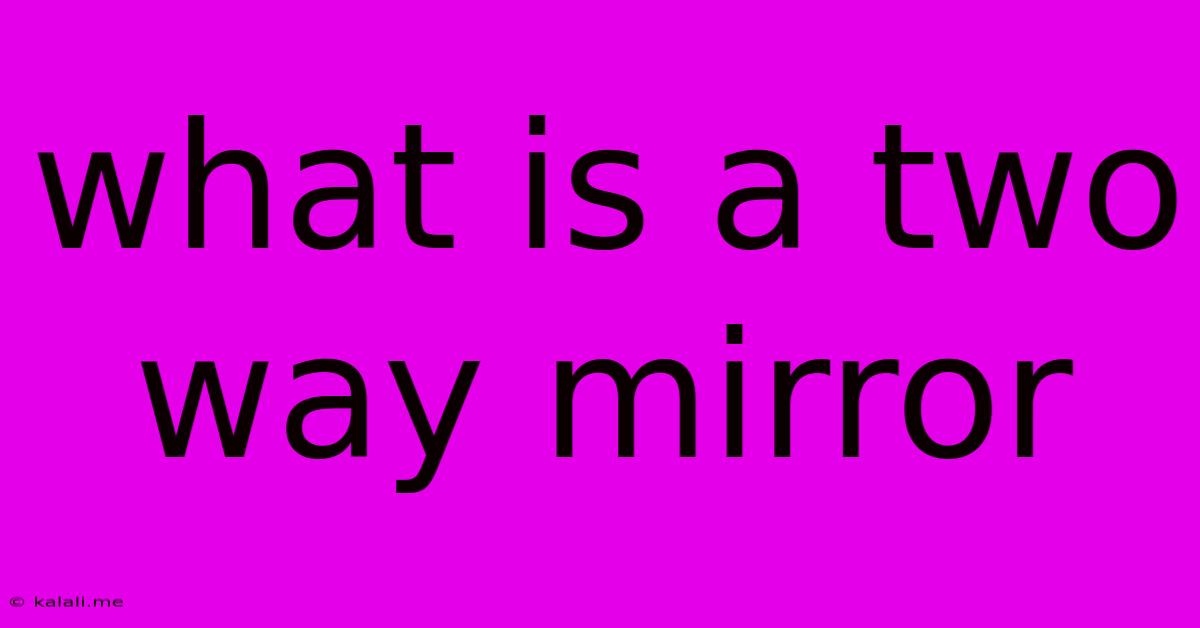What Is A Two Way Mirror
Kalali
Jun 09, 2025 · 3 min read

Table of Contents
What is a Two-Way Mirror? Unveiling the Science Behind One-Way Vision
Have you ever wondered how those mysterious, seemingly magical mirrors work in interrogation rooms or scientific labs? That's the magic of a two-way mirror, also known as a one-way mirror or half-silvered mirror. This article will delve into the science behind this intriguing technology, explaining exactly what it is, how it works, and its various applications.
A two-way mirror isn't some fantastical invention; it's a cleverly engineered piece of glass that uses the principles of light reflection and transmission to create the illusion of a one-way viewing experience. The key lies in its construction, specifically the thin coating of metallic material applied to its surface.
The Science of Reflection and Transmission
Unlike a standard mirror which reflects almost all light that strikes its surface, a two-way mirror is partially reflective and partially transmissive. This means it reflects a portion of the light while allowing the rest to pass through. The exact proportion of reflection and transmission depends on the thickness and composition of the metallic coating, typically a very thin layer of aluminum or silver.
The magic happens because of the difference in ambient lighting between the two sides of the mirror. The side with brighter lighting will reflect more light back, making it appear as a mirror to those on the darker side. Conversely, the darker side will appear more transparent to those on the brighter side.
How a Two-Way Mirror Works in Practice
Imagine a room with a two-way mirror separating it from a brightly lit observation room. Someone in the dimly lit room will mainly see their own reflection, because most of the light from the observation room is being reflected back. However, those in the brightly lit observation room can clearly see into the dimly lit room, as the light from their side passes through the mirror, allowing them to observe the events occurring on the other side.
This effect is maximized by careful control of lighting conditions. A significant difference in brightness between the two sides is crucial for the one-way viewing effect to be effective.
Applications of Two-Way Mirrors
Two-way mirrors have a wide range of applications, including:
- Law Enforcement: Interrogation rooms frequently employ two-way mirrors to allow investigators to observe suspects without being seen.
- Scientific Research: Behavioral studies and experiments often utilize two-way mirrors for unobtrusive observation of subjects.
- Retail and Marketing: Some businesses use them to observe customer behavior and improve store layout or product placement.
- Medical Training and Education: Observation of medical procedures can be facilitated without disrupting the surgical environment.
- Security: Security personnel can monitor activities without being noticed.
Identifying a Two-Way Mirror
Determining whether a mirror is a two-way mirror isn't always easy. A simple test involves placing a bright light close to the surface of the mirror. If you can see a faint reflection of what's on the other side of the glass, then it might be a two-way mirror. However, this test isn't foolproof, and the effectiveness depends on the lighting conditions.
Conclusion
Two-way mirrors are fascinating examples of how clever manipulation of light can create intriguing effects. Their wide-ranging applications demonstrate the versatility of this technology in diverse fields, from law enforcement to scientific research. While the technology itself is straightforward, the implications of its use are often complex and raise important ethical considerations, particularly concerning privacy and surveillance.
Latest Posts
Latest Posts
-
Drywall Mesh Tape Vs Paper Tape
Jun 09, 2025
-
Is The Cylinder Head Part Of The Engine
Jun 09, 2025
-
Are Living Together Partners With Children Together Considered
Jun 09, 2025
-
Are Motels Better About The Bedbug Situation From Years Ago
Jun 09, 2025
-
What To Do With Ashes From Fire Pit
Jun 09, 2025
Related Post
Thank you for visiting our website which covers about What Is A Two Way Mirror . We hope the information provided has been useful to you. Feel free to contact us if you have any questions or need further assistance. See you next time and don't miss to bookmark.